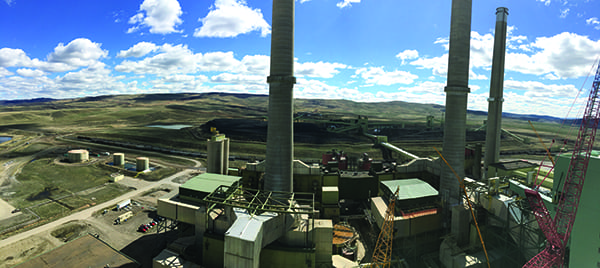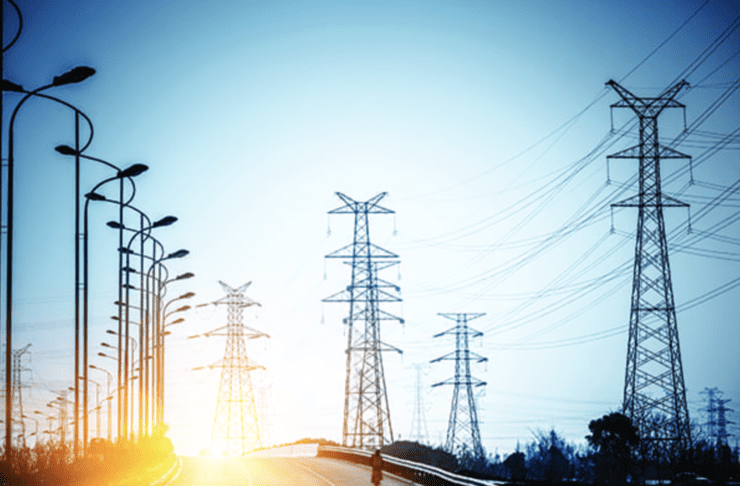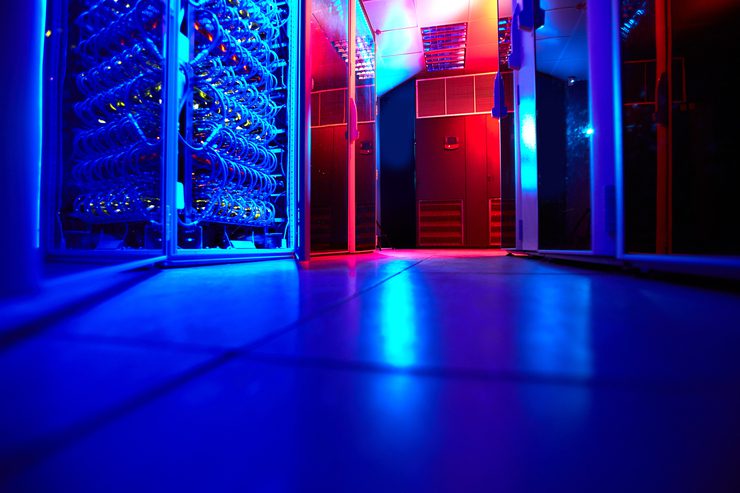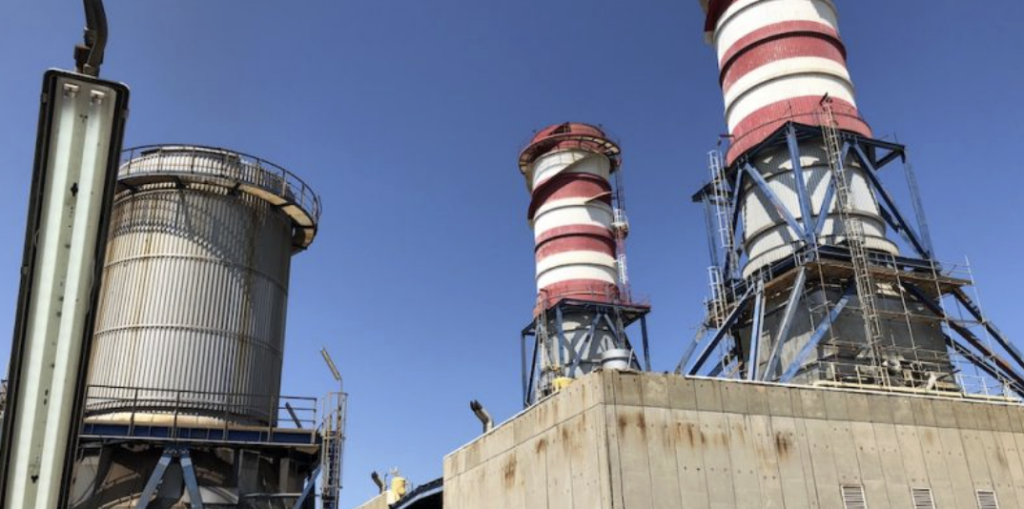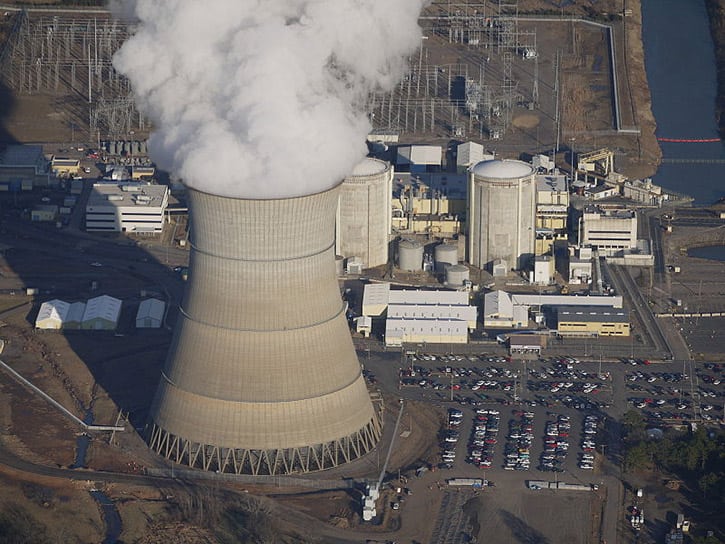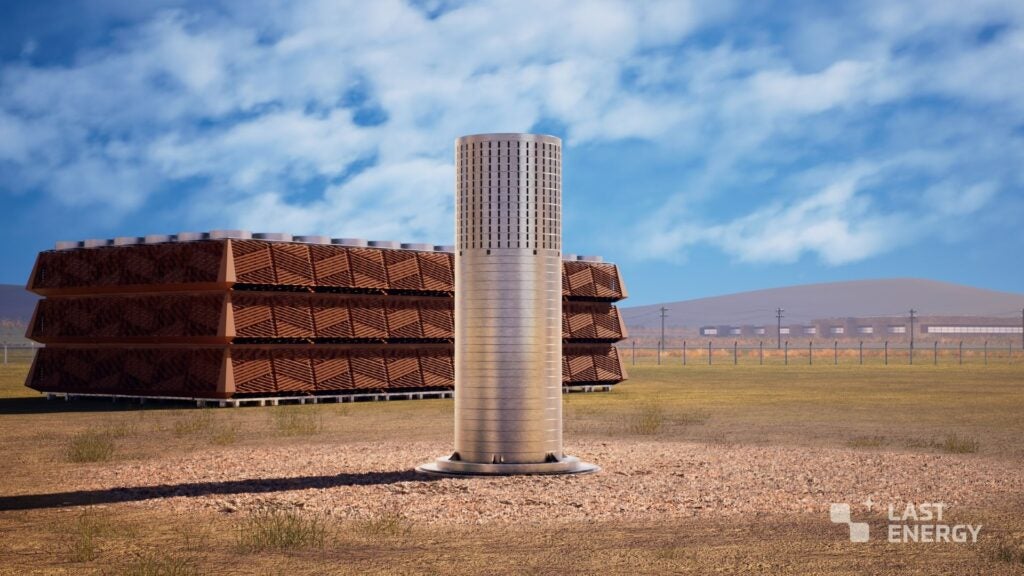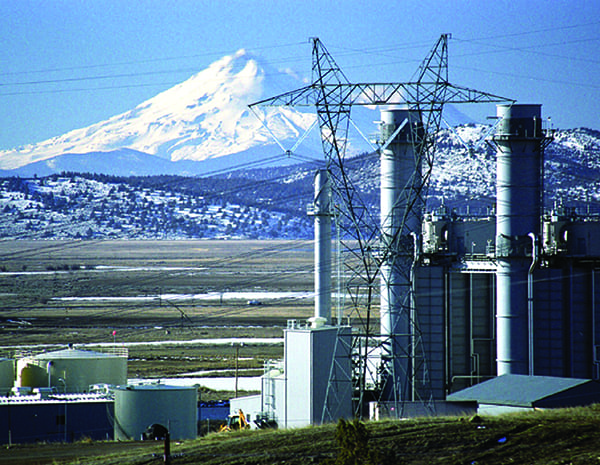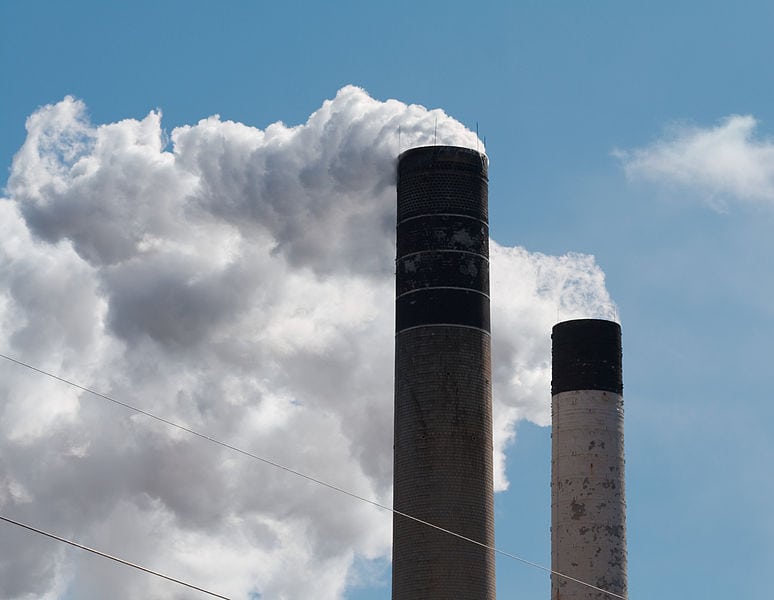Identifying areas in your plant where insulation is inadequate and fixing the problem can save significant amounts of money, eliminate safety hazards for workers, and reduce greenhouse gas emissions. It’s a win-win-win solution.
Let’s start this article with a trip down music memory lane. This 1970s classic, “Takin’ It to the Streets,” was written by Michael McDonald, keyboard player and lead singer of the Doobie Brothers. (McDonald joined the group in 1975 when guitarist Tom Johnston fell ill.) While this song takes me back to high school, it also feels in tune with the current moment, as the sustainability benefits of mechanical insulation—delivered via energy appraisals and inspections—are now “hitting the streets.” We are taking our message directly to the people: Take this message to my brother. You will find him everywhere.
Let me elaborate on why this moment is so exciting. The insulation industry’s message that mechanical insulation plays a big role in helping countries, states, cities, and companies achieve their greenhouse gas (GHG) emissions goals is resonating. Our industry does help the world be a better place. Insulation is no longer that quiet and unassuming product that gets covered up.
U.S. Journey on Global Warming and GHG Emissions
Acting upon climate change regained traction in the U.S. when we rejoined the Paris Agreement in February 2021. The Paris Agreement is a legally binding international treaty adopted by 196 countries in Paris, in December 2015, and entered into force in November 2016. The overall goal of the treaty is to limit global warming to well below 2 degrees Celsius, preferably to 1.5 degrees Celsius (2.7F), compared to pre-industrial levels.
The U.S. reentered the agreement upon the first day of the Biden Administration in January 2021. At the Earth Leaders’ Summit in April 2021 in Glasgow, Scotland, many leaders underscored the urgency of other major economies strengthening their ambition to reduce GHG emissions. The U.S. got serious and submitted a new “nationally determined contribution” (NDC) under the Paris Agreement, setting an economy-wide emissions GHG target of a 50% to 52% reduction below 2005 levels in 2030. Furthering the U.S.’s commitment to reduce GHG emissions, Congress passed the Inflation Reduction Act in August 2022, which earmarks $369 billion in “energy security and climate change” investments, with the aim of reducing carbon emissions roughly 40% by 2030. The intended aim is for these investments to broadly lower costs by building out existing energy and new renewable systems.
Not only are countries outlining bold strategies to reduce GHGs, but many businesses are also making carbon GHG emissions goals for the end of this decade and many out to 2050. At least one-fifth (21%) of the world’s 2,000 largest public companies have committed to meet net zero targets, according to a report called “Taking Stock: A global assessment of net zero targets,” which was released by the Energy and Climate Intelligence Unit, a UK-based non-profit organization that supports informed debate on energy and climate change issues. The companies making the net zero commitments together represent sales of nearly $14 trillion. As an example, Amazon unveiled a plan in 2019 to make the company carbon neutral by 2040. American Electric Power has a carbon emission reduction goal to reduce CO2 emissions by more than 80%, with an aspiration to be net-zero by 2050. They have already made significant progress in reducing their carbon footprint, cutting emissions by 65% since 2000.
Mechanical Insulation Is an Obvious Choice to Reduce GHG Emissions
Clearly, the goal is to lower GHG emissions, but what on earth can we do? Our industry would like to think that mechanical insulation is an obvious choice: the cheapest form of energy is the energy you don’t use in the first place—insulation works! Whether we’re talking homes, commercial office buildings, or industrial operations, insulation is all about the business of helping reduce energy consumption.
While alternative technologies focus on ways to generate energy more efficiently, the insulation sector remains focused on how to conserve energy and utilize it more efficiently. And to think that insulation is a simplistic technology—it generally works by trapping air. Insulations of all types don’t stop heat transfer—they slow it down. The higher the R value (resistance to heat flow) of a material, the slower or less efficiently a material conducts heat and allows hot or cold to move thru it. Gases—such as air—are excellent insulators because the molecules are farther apart than solids or liquids, thereby making heat transfer very inefficient.
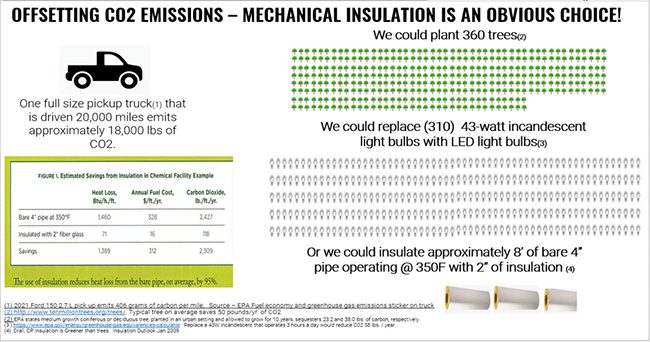 |
|
1. It is far easier to offset CO2 emissions by installing mechanical insulation than it is by replacing incandescent with LED light bulbs or planting trees. Courtesy: National Insulation Association |
Mechanical insulation reduces carbon emissions at the source—namely, by not having emissions created in the first place. Mechanical insulation drastically outshines trees and light bulbs, two more commonly discussed carbon-reducing strategies. Figure 1 shows the power of mechanical insulation. Insulating 8 feet of 4-inch diameter pipe running at 350F with just two inches of pipe insulation can offset 20,000 miles of CO2 emissions (9 tons) from a 2021 2.7-liter truck. Insulating 8 feet of pipe one time compares to annually planting 360 trees or changing out 310 43-watt incandescent light bulbs with LED bulbs.
Not only does it have high calorie impact from a GHG standpoint—it is very economical. For instance, an installed price for that same 8 feet of pipe would be about $400. Thus, the math comes to $400 to save around 9 tons of CO2. That comes to about $44/ton. There are other technologies that are much more sophisticated than mechanical insulation and have been developed to reduce CO2 at the source, or even more complex technologies that suck CO2 out of the air. Our federal government, primarily the Department of Energy (DOE), and private companies have been busy investing millions of dollars in the new technologies, but these technologies cost from several hundred dollars to thousands of dollars per ton.
Another metric to evaluate is the footprint and handprint of a product. Footprint is a newer term for what we used to call pollution. A more formal meaning is “a measure of the resources necessary to produce the goods that an individual or population consumes.” Handprint is simply the benefit of a product to the world. Footprint “takes,” while handprint “gives.” At the end of the day, if the handprint of the product is better than the footprint, the result will be advantageous to the world.
To tie all this together and provide an example, readers also need to understand Environmental Product Declarations (EPDs). An EPD is the main document that quantifies the amount of potential environmental impacts of a manufacturer’s products during its entire lifecycle. These include global warming potential, as well as other indicators for air and water. As an example, one member company of the National Insulation Association (NIA) has documented via an EPD that the pipe covering mentioned in the pictogram example of 350F that it takes about 7.3 pounds of CO2 to produce one lineal foot of pipe insulation—the footprint (impact). The handprint (benefit) of that same one foot—is 2,300 pounds per year of CO2 savings.
NIA Past President Ron King wrote in a January 2010 Insulation Outlook article, “Mechanical insulation and insulation in general are among the few industrially manufactured products that save more energy over their life span than is required for their manufacturing. NIA has estimated that mechanical insulation systems save more than 140 and up to 500 times more energy over their life spans (20 years for the purposes of this discussion) than it takes to produce them. This is based on performance comparison of surfaces with and without insulation. Mechanical insulation also saves a minimum of 150 (and up to 750) times more CO2 emissions than it takes to produce the insulation product. The data proves that mechanical insulation is a sustainable, green initiative that provides an unparalleled ecobalance.”
Insulation Energy Appraisals
Conducting an insulation energy appraisal is a great way for a company or site location to build their base emissions dataset and make notes of any missing or damaged insulation. (See www.insulation.org/training/ieap for information on NIA’s Insulation Energy Appraisal Program, which teaches a standardized approach to conducting insulation energy appraisals.) If either energy efficiency or process control is a role for the insulation, then the appraisal gives a method of quantifying the results in British thermal units (Btus) of energy saved per year and thereby calculating dollars of energy saved per year. By taking each scope separately (such as a pipe of a certain size and temperature), one can quantify the amount of any energy loss and the dollar value of that energy loss.
In one chemical plant example, the appraiser identified approximately 11,000 details (places requiring insulation replacement or repair), with a total area of 45,000 square feet. This included many valves and flanges that had been left uninsulated, resulting in enormous unnecessary heat loss and safety hazards (due to the high temperatures, which can cause burns). The total estimate to replace this insulation was about $2.2 million, or $200 per detail, including costs for removal and disposal of old insulation, new insulation materials, labor to install, scaffolding where necessary, and other ancillary costs. Since this facility normally spends $300,000 to $400,000 annually for insulation maintenance, the $2.2 million estimate was more than the facility owners were prepared to spend at one time. Consequently, the appraiser prioritized the details in terms of heat loss, and facility management focused on the work that would save the greatest amount of energy before moving on to smaller details.
Shannon Global Energy Solutions in New York documented savings on a 350F steam system with only 48 fittings. By adding only 1.5-inches of removable/reusable insulation covers to areas such as valves, steam drums, flanges, and strainers, Shannon showed a 10-month payback on a $31,000 installed job. Better yet, the CO 2 savings were 444 tons by adding the insulation to these 48 areas. Doing a simple calculation, this comes to a cost of $70 per CO2 ton removed. A key measure to show productivity of a project is return on investment (ROI) to remove a ton of CO2.
Fit Tight Covers in Evansville, Indiana, recently documented how an energy appraisal helped its client greatly reduce CO2 emissions as part of the company’s 2025 carbon reduction goals. After upgrading their mechanical insulation, analysis showed that one plant alone saved approximately 4.5 million pounds of CO2 per year, while at the same time reducing its annual operational energy costs from $102,000 to $8,000. This was calculated using $2.50 per dekatherm for natural gas, and as educated readers know, natural gas prices have been higher than $9 per dekatherm this year.
Don’t Delay, Conduct a Survey Today
Think insulation first and get an energy survey performed to get a baseline of your savings. Mechanical insulation is saving energy and the planet. Who says you can’t have it all? Old-fashioned mechanical insulation—it’s not low hanging fruit—it’s fruit on the ground!
The information in this article was originally presented in a free webinar by the Energy Management Association. To sign up for future webinars and trainings, visit www.energymgmt.org.
—David J. Cox is immediate past president of the National Insulation Association (NIA).




